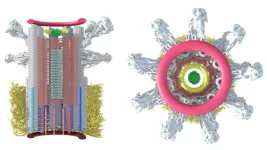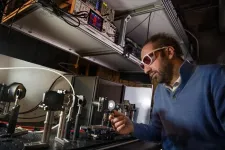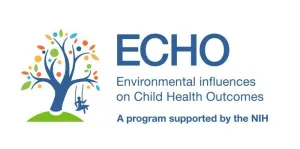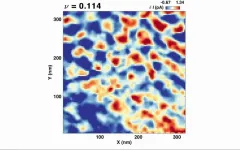(Press-News.org) NEW YORK, NY (April 10, 2024)--Columbia researchers have discovered a genetic variant that reduces the odds of developing Alzheimer’s disease by up to 70% and may be protecting thousands of people in the United States from the disease.
The discovery of the protective variant, which appears to allow toxic forms of amyloid out of the brain and through the blood-brain barrier, supports emerging evidence that the brain’s blood vessels play a large role in Alzheimer's disease and could herald a new direction in therapeutic development.
“Alzheimer’s disease may get started with amyloid deposits in the brain, but the disease manifestations are the result of changes that happen after the deposits appear,” says Caghan Kizil, PhD, a co-leader of the study that identified the variant and associate professor of neurological sciences (in neurology and in the Taub Institute) at Columbia University Vagelos College of Physicians and Surgeons.
“Our findings suggest that some of these changes occur in the brain’s vasculature and that we may be able to develop new types of therapies that mimic the gene’s protective effect to prevent or treat the disease.”
An attractive drug target?
The protective variant identified by the study occurs in a gene that makes fibronectin, a component of the blood-brain barrier, a lining surrounding the brain’s blood vessels that controls the movement of substances in and out of the brain.
Fibronectin is usually present in the blood-brain barrier in very minute amounts, but it is increased in large amounts in people with Alzheimer’s disease. The variant identified in the fibronectin gene seems to protect against Alzheimer’s disease by preventing the buildup of excess fibronectin at the blood-brain barrier.
"It’s a classic case of too much of a good thing,” Kizil says. “It made us think that excess fibronectin could be preventing the clearance of amyloid deposits from the brain.”
The researchers confirmed that hypothesis in a zebrafish model of Alzheimer’s disease and have additional studies in mice underway. They also found that reducing fibronectin in the animals increased amyloid clearance and improved other damage caused by Alzheimer’s disease.
“These results gave us the idea that a therapy targeting fibronectin and mimicking the protective variant could provide a strong defense against the disease in people,” says study co-leader Richard Mayeux, MD, chair of neurology and the Gertrude H. Sergievsky Professor of Neurology, Psychiatry, and Epidemiology.
The newest treatments for Alzheimer’s disease target the amyloid deposits directly and are very efficient at removing the deposits via the immune system. However, simply removing the deposits this way doesn’t improve symptoms or repair other damage.
“We may need to start clearing amyloid much earlier and we think that can be done through the bloodstream,” Mayeux adds. “That's why we are excited about the discovery of this variant in fibronectin, which may be a good target for drug development.”
Protective gene was found in people resilient to Alzheimer’s disease
The researchers discovered the protective variant in people who never developed symptoms but who had inherited the e4 form of the APOE gene, which significantly increases the risk of developing Alzheimer’s disease.
“These resilient people can tell us a lot about the disease and what genetic and non-genetic factors might provide protection,” says study co-leader Badri N. Vardarajan, PhD, assistant professor of neurological science (in neurology, the Gertrude H. Sergievsky Center, and the Taub Institute), who is an expert in using computational approaches to discover Alzheimer’s disease genes.
"We hypothesized that these resilient people may have genetic variants that protect them from APOEe4.”
To find protective mutations, the Columbia researchers sequenced the genomes of several hundred APOEe4 carriers over age 70 of various ethnic backgrounds, including those with and without Alzheimer's disease. Many participants were residents of Northern Manhattan who were enrolled in the Washington Heights/Inwood Columbia Aging Project, an ongoing study that has been conducted by Columbia University’s Department of Neurology for more than 30 years.
The study identified the fibronectin variant, and the Columbia team publicized their results in a preprint for other researchers to view. Based on the Columbia team’s observations, another group from Stanford and Washington universities replicated the study in an independent cohort of APOEe4 carriers, mostly of European origin.
“They found the same fibronectin variant, which confirmed our finding and gave us even more confidence in our result,” Vardarajan says.
The two groups combined the data on their 11,000 participants, which allowed them to calculate that the mutation reduces the odds of developing Alzheimer’s in APOE4 carriers by 71% and forestalls the disease by roughly four years in those who eventually develop the disease.
The researchers estimate that 1% to 3% of APOEe4 carriers in the United States—roughly 200,000 to 620,000 people—may also carry the protective fibronectin mutation.
Wide therapeutic potential
The fibronectin variant, though discovered in APOEe4 carriers, could protect against Alzheimer’s disease in people with other forms of APOE.
“There’s a significant difference in fibronectin levels in the blood-brain barrier between cognitively healthy individuals and those with Alzheimer's disease, independent of their APOEe4 status,” Kizil says.
“Anything that reduces excess fibronectin should provide some protection, and a drug that does this could be a significant step forward in the fight against this debilitating condition.”
More information
The study, “Rare genetic variation in Fibronectin 1 (FN1) protects against APOEε4 in Alzheimer’s disease,” was published online April 10 in the journal Acta Neuropathologica.
Richard Mayeux, MD, is also director of the Gertrude H. Sergievsky Center and co-director of the Taub Institute for Research on Alzheimer's Disease and the Aging Brain at Columbia University Vagelos College of Physicians and Surgeons and neurologist-in-chief at NewYork-Presbyterian/Columbia University Irving Medical Center. (Other contributors are listed in the paper.)
###
Columbia University Irving Medical Center (CUIMC) is a clinical, research, and educational campus located in New York City. Founded in 1928, CUIMC was one of the first academic medical centers established in the United States of America. CUIMC is home to four professional colleges and schools that provide global leadership in scientific research, health and medical education, and patient care including the Vagelos College of Physicians and Surgeons, the Mailman School of Public Health, the College of Dental Medicine, the School of Nursing. For more information, please visit cuimc.columbia.edu.
END
Newly found genetic variant defends against Alzheimer’s disease
2024-04-10
ELSE PRESS RELEASES FROM THIS DATE:
Serious flu damage prevented by compound that blocks unnecessary cell death
2024-04-10
As lung cells are killed by the influenza virus, they burst open, releasing molecular signals that trigger the immune cells that can combat the infection. This strategy can be an important red flag that something is wrong; however, if one cell death response, called necroptosis, continues unchecked, it can cause life-threatening injury to lung tissue. In a study published April 10 in the journal Nature, Tufts University School of Medicine scientists and collaborators present a newly developed compound ...
CHOP, Stanford researchers identify protein that controls CAR T cell longevity
2024-04-10
Philadelphia, April 10, 2024 – CAR T cell therapy has revolutionized the way certain types of cancer are treated, and the longer those CAR T cells live in a patient’s body, the more effectively they respond to cancer. Now, in a new study, researchers at Children’s Hospital of Philadelphia (CHOP) and Stanford Medicine have found that a protein called FOXO1 improves the survival and function of CAR T cells, which may lead to more effective CAR T cell therapies and could potentially expand its use in difficult-to-treat cancers. The findings were published online today by the journal Nature.
T ...
Race, ethnicity, and delayed time to COVID-19 testing among health care workers
2024-04-10
About The Study: In this cross-sectional study of health care personnel (HCP), compared with non-Hispanic white HCP and clinical HCP with graduate degrees, non-Hispanic Black HCP, non-Hispanic HCP of other races, and HCP of all other professional and education backgrounds were more likely to have delayed COVID-19 testing. These findings suggest that time to testing may serve as a valuable metric in evaluating sociodemographic disparities in the response to COVID-19 and future health mitigation strategies.
Authors: DaMarcus ...
Trends in deaths of despair by race and ethnicity
2024-04-10
About The Study: As of 2022, the midlife mortality rates from deaths of despair (deaths from suicide, drug overdose, and alcoholic liver disease) among Black individuals were higher than rates among white individuals, and rates among American Indian or Alaska Native individuals remained higher than rates in the other groups. Rising inequalities in deaths of despair among American Indian or Alaska Native and Black individuals were largely attributable to disproportionate early mortality from drug- and alcohol-related causes, which increased leading up to and during the COVID-19 pandemic.
Authors: Joseph ...
Revolutionary molecular device unleashes potential for targeted drug delivery and self-healing materials
2024-04-10
In a new breakthrough that could revolutionise medical and material engineering, scientists have developed a first-of-its-kind molecular device that controls the release of multiple small molecules using force.
The researchers from The University of Manchester describe a force-controlled release system that harnesses natural forces to trigger targeted release of molecules, which could significantly advance medical treatment and smart materials.
The discovery, published today in the journal Nature, uses a novel technique using a type of interlocked molecule known as rotaxane. Under the influence of mechanical force - such ...
The genesis of our cellular skeleton, image by image
2024-04-10
Cells contain various specialised structures - such as the nucleus, mitochondria or peroxisomes - known as “organelles’’. Tracing their genesis and determining their structure is fundamental to understanding cell function and the pathologies linked to their dysfunction. Scientists at the University of Geneva (UNIGE) have combined high resolution microscopy and kinematic reconstruction techniques to visualise, in motion, the genesis of the human centriole. This organelle, essential to the organisation of the cell skeleton, is associated - in case of dysfunction - with certain cancers, brain disorders or retinal diseases. This work, published in the journal Cell, elucidates ...
Quantum breakthrough when light makes materials magnetic
2024-04-10
The potential of quantum technology is huge but is today largely limited to the extremely cold environments of laboratories. Now, researchers at Stockholm University, at the Nordic Institute for Theoretical Physics and at the Ca’ Foscari University of Venice have succeeded in demonstrating for the very first time how laser light can induce quantum behavior at room temperature – and make non-magnetic materials magnetic. The breakthrough is expected to pave the way for faster and more energy-efficient computers, information transfer and data storage.
Within a few decades, the advancement of quantum technology ...
Living near green space associated with fewer emotional problems in preschool-age kids, NIH study finds
2024-04-10
Children who live in areas with natural spaces (e.g., forests, parks, backyards) from birth may experience fewer emotional issues between the ages of 2 and 5, according to a study funded by the NIH Environmental Influences on Child Health Outcomes (ECHO) program.
While research has suggested that time in nature is important for mental health, studies examining the effects on young children are limited. ECHO investigators addressed this research gap by analyzing information from parents about the behavior of their children from ages 2 to 11. They combined this data with the family’s ...
Researchers explore role of androgens in shaping sex differences
2024-04-10
Sex differences are widespread across human development, physiological processes, and diseases, making it important to characterize the impact of sex differences in these areas. Understanding the regulatory mechanisms associated with these differences, including the role of androgens, is also vital for clinical translation—especially for diseases more prevalent in one sex.
To answer these questions, a team led by Prof. GAO Dong and Prof. CHEN Luonan from the Center for Excellence in Molecular Cell Science, Shanghai Institute ...
Quantum crystal of frozen electrons—the Wigner crystal—is visualized for the first time
2024-04-10
Electrons—these infinitesimally small particles that are known to zip around atoms—continue to amaze scientists despite the more than a century that scientists have studied them. Now, physicists at Princeton University have pushed the boundaries of our understanding of these minute particles by visualizing, for the first time, direct evidence for what is known as the Wigner crystal—a strange kind of matter that is made entirely of electrons.
The finding, published in the April 11th issue of the journal Nature, confirms a 90-year-old ...





